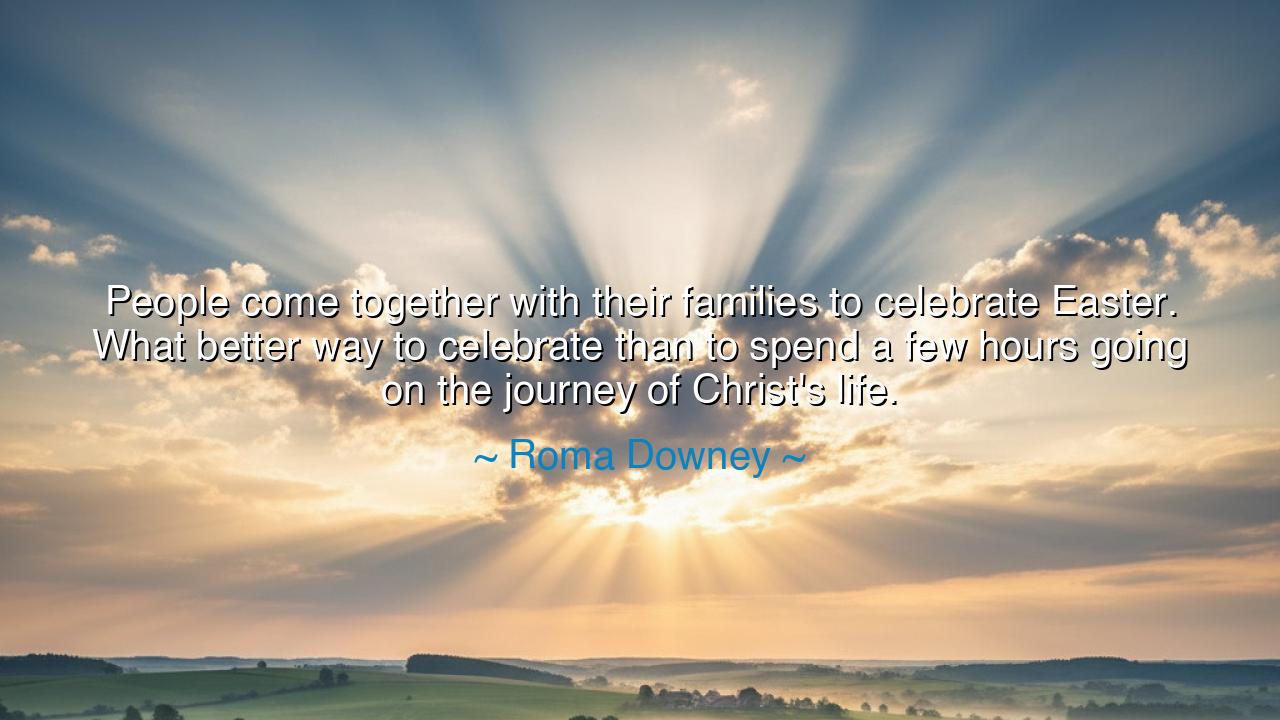
People come together with their families to celebrate Easter.
People come together with their families to celebrate Easter. What better way to celebrate than to spend a few hours going on the journey of Christ's life.






In the gentle yet profound words of Roma Downey, “People come together with their families to celebrate Easter. What better way to celebrate than to spend a few hours going on the journey of Christ's life,” we hear not merely a reflection on a holiday, but a sacred invitation — a call to return to the essence of faith, to remember not the symbols of celebration alone, but the story of redemption that gives the day its meaning. Her words carry a tender wisdom: that Easter, at its heart, is not only about feasts or gatherings, but about renewal, sacrifice, and the eternal journey of the human soul walking beside the divine.
To understand the depth of her sentiment, we must look beyond the customs of Easter — the eggs, the flowers, the morning sun — and see what lies beneath: the resurrection of hope. For centuries, families have gathered on this day to remember the triumph of life over death, of love over despair. Downey, known for bringing stories of faith to life on screen, reminds us that the truest way to honor Easter is to walk again through the story of Christ’s life, to relive His compassion, His suffering, His forgiveness, and His victory over the grave. In doing so, we do not simply recall history; we rekindle faith within ourselves and pass it to our children like a flame that refuses to die.
This “journey of Christ’s life” is the same path that countless souls throughout history have walked in their own way. Saint Francis of Assisi, for instance, lived each day as a living reflection of the Gospel — abandoning wealth, embracing humility, and serving the poor. His life was not merely inspired by Christ’s teachings; it was a reenactment of them. To celebrate Easter as Downey suggests is to do as Francis did: to not only admire the story from afar, but to enter it, to feel its sorrow and its splendor until it reshapes the way we live and love. For faith, if left unwalked, remains only a story — but when lived, it becomes truth.
The ancients knew that stories were sacred vessels — that through retelling and re-living, wisdom finds its way into the soul. The Greeks spoke of catharsis, the purification of the heart through the drama of life. Likewise, the Christian story of Easter is not merely one of joy; it is one of transformation through pain. When Downey speaks of “spending a few hours going on the journey of Christ’s life,” she speaks of entering that timeless rhythm — of dying to what is false within us, so that something pure may rise. In this way, Easter becomes not a single day of observance, but a mirror of our own lives, where every trial can become resurrection, every sorrow a doorway to grace.
There is also a deeper wisdom in her mention of family. For it is through the gathering of hearts, not the grandeur of ceremony, that faith is truly reborn. In ancient times, families would sit by firelight and tell the stories of heroes and gods — not for entertainment, but to shape the souls of their children. So too does Downey call us to gather in the light of faith, to share with one another not the noise of the world but the quiet power of Christ’s story. When a family remembers together, it becomes a temple; when it loves together, it becomes holy ground.
Consider how in times of hardship — in war, exile, or loss — people have turned to the story of Christ for strength. In the dark days of World War II, imprisoned believers held secret Easter services, whispering the Gospel under threat of death. They had no candles, no altars, no fine garments — only the memory of a man who conquered despair with forgiveness. In that remembrance, they found freedom of the soul even behind bars. This is the power of what Downey describes — to journey through Christ’s life is to rediscover courage, to remember that even the darkest tomb cannot hold the light forever.
The lesson of Roma Downey’s words is simple yet eternal: celebration without reflection is hollow. To honor Easter is not merely to rejoice, but to remember why we rejoice — because love conquered death, and that same love lives in us. She invites us not to be spectators of faith, but participants in it. This means setting aside time — amidst feasts, laughter, and family — to walk with Christ in heart and mind, to meditate on His kindness, His trials, His mercy.
So, my friends, when Easter dawns, let your celebration be more than ritual. Let it be a pilgrimage of the heart. Tell the story to your children; read of His compassion to the old and the young alike; walk, if only in spirit, beside Him through Galilee, Gethsemane, and Golgotha. For in doing so, you will not only celebrate Easter — you will live it. And in living it, you will feel what the ancients called anamnesis — a holy remembering — the kind that turns history into presence, and belief into the beating pulse of life renewed.






AAdministratorAdministrator
Welcome, honored guests. Please leave a comment, we will respond soon